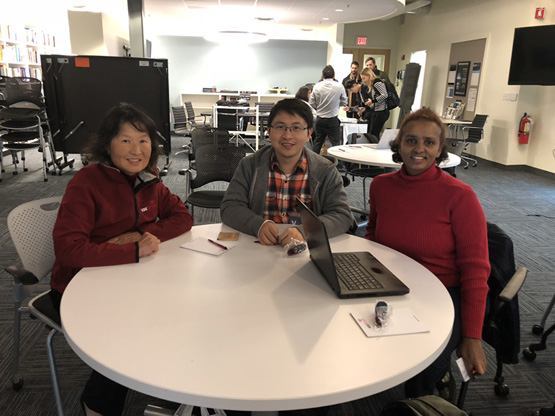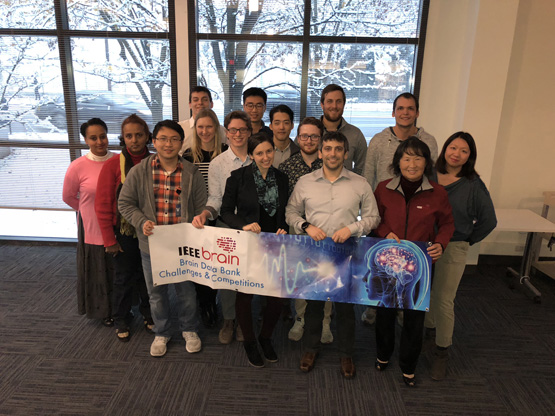NEW: STUDENT CORNER
Note from the editor: As part of the IEEE commitment to educating a new generation of engineers, the IEEE Brain Initiative eNewsletter BrainInsight is launching a new space called the “Student Corner” for young researchers to present their opinions on current events or research topics. We invite thus MSc and early career PhD students to submit their contributions by contacting the managing editor.
Foreword by N. Nan Chu, the IEEE Brain Data Bank Competition Initiator. Contact Information: narisa.chu@ieee.org
I have coached graduate students from University of Missouri-Kansas City (UMKC) to participate in the IEEE Brain Initiative sponsored Challenges/Competitions. Leader of the UMKC Ph.D. students is Haymanot Gebre-Amlak, who has been intrigued by the state-of-the-art brain technology after listening to my speech at the International Conference on Consumer Electronics (ICCE-2017.) She recruited many colleagues to join her curiosity journey by observing IEEE events on-line, which took place in St. Petersburg, Russia and Glasgow, UK. Finally, in Boston, with relatively affordable travel expenses, they formed 2 teams (each team could only have 5 members maximum, so they had to break their crowd into two groups) to participate in Boston Competition. (Noted it was also their first experience of a Boston blizzard, most members were born in tropical countries.) What follows provide their brief impression of the highly-regarded competition in 2017. Indeed, their interests and learning have continued toward the 2018 BDB Competition, currently being organized in Xi’an, China.

Dr. Nan Chu, Mark Nguyen and Helen Gebre-Amlak (left to right,) during the Boston Brain Data Bank Competition at Charles River Analytics, Dec. 9, 2017.
Haymanot (Helen) Gebre-Amlak
is an interdisciplinary Ph.D. candidate at University of Missouri – Kansas City. Her main discipline is Telecommunication and Computer Network, with co-discipline, Economics. Her research interests include network traffic/performance analysis and modeling, software-defined network, wireless sensors, Internet of Things (IoT), reliable network and Big Data. Contact Information: hhgc77@umkc.edu
IEEE made it possible for me to participate in one of the IEEE Brain Data Bank (BDB) Competitions, held in Boston, USA, in December 2017. I had attended the International Conference of Consumer Electronics in Las Vegas back in January 2017 where I heard about the different Brain challenges and competitions organized by IEEE for the first time from Dr. Narisa Nan Chu, the Initiator of Global Brain Competitions for the IEEE Brain Initiative. Upon seeing the Call for Participation of the BDB Competition in Boston, I was excited by the opportunity to attend and compete. I started recruiting teammates for the competition from my university as well as from University of Kansas Medical Center.
Since our first introduction in January 2017, Dr. Chu has served as a mentor to help me understand more about Brain Computer Interfaces because my background is primarily in computer science and networking. As a warm-up, I had access to the dataset from University of California – San Francisco (UCSF), made available for the IEEE BDB Challenges held in St. Petersburg, Russia and Glasgow, Scotland, prior to the Boston Competition. I also attended the tutorial lesson given by Dr. Chu for participants of the Glasgow Challenge, which helped me gain a better understanding of brain data and how to read the data.
The dataset for the Boston competition was provided by the University of Illinois at Urbana–Champaign (UIUC) and it was a truncated set of a broader intervention-based study. This dataset was completely different from the UCSF dataset in its background testing, goals, type of data provided and published literatures. It gave us some time (although never enough time) to think about different approaches to analyze brain data. The UIUC dataset (fMRI data) was different from the UCSF dataset (signals collected from a 64 channel EEG head cap acquisition system). In addition, we had to develop code to convert the fMRI data values into SPSS readable format to start our analysis process. Attending the pre-competition webinar was very helpful to get some answers for the questions that were raised during our team weekly meeting to enhance our understanding of the UIUC dataset.
Lessons Learned:
There were 5 groups who presented at the conference; two of the groups came from my university, University of Missouri – Kansas City and Medical Center. I worked closely with both groups and have a good understanding of the approaches both teams took. Watching the other three groups present gave me different views to the data that were provided. I learned a lot from the presentations and from networking with other participants. The top 3 winner groups used different approaches to analyze the fMRI data. For example, the first prize winner focused on the size of the brain between men and women, while the second prize focused on the heat of the brain from different subjects. The third group provided regression testing result of the fMRI.
The competition gave me the opportunity to sharpen my programming skills including Perl and Python. I developed a script to convert the large size matrix into one vector for Machine Learning input data, and Python scripts to generate the delta set between the pre-and-post matrix and for optimizing SPSS statistical analysis. Moreover, the size of the dataset was too big and needed to be converted to make it usable. For machine learning, these data needed to be converted to vector. The skills I learned from the competition were very valuable and help automate the tasks of my current research work.
To conclude, I would like to thank the IEEE Brain Initiative organizers for giving me the opportunity and support to attend the IEEE Brain Data Bank Conference in Boston.


Impressions of the IEEE Brain Data Bank Competition in Boston
Duc Huy Hoang (Mark) Nguyen
is a PhD student at University of Missouri, Kansas City studying Machine Learning, Image Processing, and Biometrics. His research interests include soft biometrics, image matching, and deep learning. Contact information: hdnf39@mail.umkc.edu
I first heard about the IEEE Brain Data Bank Competition – Boston from one of my colleagues, Haymanot (Helen) Gebre-Amlak. Helen and I come from different backgrounds. I specialize in machine learning, image processing, and biometric while her background is in computer science. When I heard about Helen and Dr. Narisa Nan Chu’s work with brain computer interface, I knew that machine learning could play a crucial role in making brain data meaningful. However, the data that we have are not fully organized and developed for machine learning algorithm. When I heard about the competition, I was so excited since it is well suitable for my purpose.
I have been in many hackathons when I was an undergraduate student but I found the time limitation, usually 24-48 hours to develop an application, problematic. I really like the IEEE Brain Data Bank Competition since I had more than two weeks to explore the data. The pre-competition conference call was very crucial for competitors to understand the given data.
The dataset for the Boston competition was provided by University of Illinois at Urbana–Champaign (UIUC) and consists of fMRI brain recordings of 25 subjects before and after intervention which involved 48 training sessions of visual and change detection tasks/games. With the designed pre-intervention and post intervention process, subjects were asked to take Law School Admissions Test (LSAT). I decided to use basic machine learning algorithm to predict whether the performance in LSAT of the subject improves after the intervention, using the changes in resting-state fMRI data.
Lessons Learned:
With the complexity of the data, I thought that machine learning was the only technology able to analyze them. However, the other competing teams tackled the problem in unexpected aspects such as analyzing the LSAT performance change using brain size or brain heat map. Even though I did a very thorough analysis using machine learning, I made a serious mistake of not spending a reasonable amount of time to prepare for the presentation. Therefore, my presentation failed to adequately explain my method and results to the panel of judges.
The IEEE Brain Data Bank Competition was one of the most organized events that I’ve joined. The panel of judges came from different backgrounds, including representatives from industry, academia, and government, to ensure a fair perspective in judging the competition. Competition instructions and data were formally delivered to all the teams with very clear explanations. The dataset was provided to the competition participants through the IEEE DataPort. Nonetheless, the limitation in the number of subjects was the only disadvantage of the dataset, as it prevented us from drawing solid conclusions about the intervention. Unfortunately, the data are not publicly available making it impossible to continue working on it after the competition. In my opinion, if there is an opportunity, having access to the full dataset would enable competitors to complete their work and potentially publish their results and findings.


